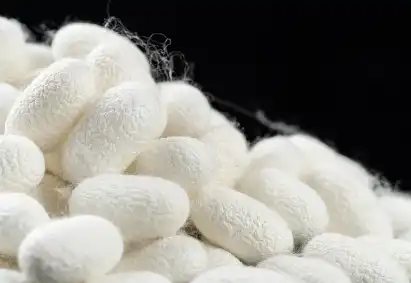Silk Fibroin in Cosmetic & Skincare Formulations
2025-06-26 14:00:23
The beauty industry is constantly evolving, seeking innovative ingredients to enhance skincare formulations. One such ingredient making waves is silk fibroin powder, a natural protein derived from silkworm cocoons. This versatile component offers numerous benefits for skin health and appearance, making it a prized addition to cosmetic products.
In this comprehensive guide, we'll explore the unique properties of silk fibroin and its applications in skincare formulations. From its ability to penetrate the skin to its anti-aging effects and formulation challenges, we'll uncover why this ingredient is becoming a staple in high-end skincare products.

Silk fibroin nanoparticles for enhanced product penetration
One of the most significant advantages of silk fibroin in skincare formulations is its ability to enhance product penetration. This is achieved through the use of silk fibroin nanoparticles, which can effectively deliver active ingredients deeper into the skin.
The science behind nanoparticle delivery
Silk fibroin nanoparticles are incredibly small, typically ranging from 50 to 200 nanometers in size. This minuscule size allows them to penetrate the skin's barrier more easily than larger molecules. When active ingredients are encapsulated within these nanoparticles, they can be transported more effectively to the deeper layers of the skin where they can exert their beneficial effects.
Benefits of enhanced penetration
The improved penetration offered by silk fibroin nanoparticles leads to several benefits for skincare formulations:
- Increased efficacy of active ingredients
- Prolonged release of skincare actives
- Better targeting of specific skin layers
- Potential for lower concentrations of active ingredients
These advantages make silk fibroin powder an attractive option for formulators looking to create more effective and efficient skincare products.

Anti-aging benefits: How it reduces fine lines better than hyaluronic acid
While hyaluronic acid has long been hailed as a powerhouse ingredient for anti-aging, silk fibroin is emerging as a formidable competitor in the fight against fine lines and wrinkles.
Silk fibroin's unique moisturizing properties
Silk Fibroin Powder possesses exceptional moisture-binding capabilities. Its molecular structure allows it to form a protective film on the skin's surface, effectively locking in moisture. This film is breathable and flexible, unlike some synthetic film-forming agents that can feel heavy or suffocating on the skin.
Collagen production stimulation
One of the key ways silk fibroin outperforms hyaluronic acid is in its ability to stimulate collagen production. While hyaluronic acid primarily works by attracting and retaining moisture, silk fibroin goes a step further by encouraging the skin to produce more of its own collagen. This leads to improved skin elasticity and firmness over time.
Long-term skin structure improvement
The amino acid composition of silk fibroin, particularly its high content of glycine, alanine, and serine, closely mimics that of human skin. This similarity allows silk fibroin to integrate well with the skin's natural structure, providing long-lasting improvements in skin texture and appearance.

Formulation challenges: Stabilizing silk fibroin in skincare products
While the benefits of silk fibroin powder in skincare are clear, incorporating it into formulations does present some challenges. Understanding and overcoming these hurdles is crucial for creating effective and stable products.
pH sensitivity
Silk fibroin is sensitive to pH changes, which can affect its stability in formulations. The protein tends to be most stable at a slightly acidic pH, typically between 4 and 6. Formulators must carefully balance the pH of their products to ensure the silk fibroin remains stable and effective.
Solubility issues
Another challenge is the solubility of silk fibroin. In its native form, silk fibroin is not water-soluble, which can make it difficult to incorporate into aqueous-based skincare formulations. To overcome this, manufacturers often use hydrolyzed silk fibroin or create specialized dispersions.
Preservative compatibility
As a protein-based ingredient, silk fibroin can be susceptible to microbial growth. Choosing the right preservative system is crucial to ensure product safety and stability. However, some preservatives may interact with the silk fibroin, potentially altering its beneficial properties. Formulators must carefully select preservatives that are compatible with silk fibroin while still providing adequate protection against microbial contamination.
Processing considerations
The processing of silk fibroin can significantly impact its properties and effectiveness in skincare formulations. High temperatures and certain mechanical stresses can denature the protein, reducing its beneficial effects. Manufacturers must employ gentle processing techniques to maintain the integrity of the silk fibroin throughout the production process.
Emulsion stability
In emulsion-based formulations, silk fibroin can sometimes interfere with emulsion stability. Its film-forming properties may disrupt the oil-water interface, leading to separation. Formulators often need to adjust their emulsifier systems or incorporate additional stabilizers to ensure a stable and homogeneous product.
Despite these challenges, the potential benefits of silk fibroin in skincare make it worth the effort to overcome these formulation hurdles. As research continues and formulation techniques improve, we can expect to see even more innovative uses of this remarkable ingredient in the cosmetic industry.
Conclusion
Silk fibroin represents a significant advancement in skincare formulations, offering enhanced product penetration, superior anti-aging benefits, and unique moisturizing properties. While it presents some formulation challenges, the potential rewards make it a valuable ingredient for cosmetic and skincare brands looking to create high-performance products.
As the beauty industry continues to evolve, ingredients like silk fibroin powder demonstrate the power of nature-inspired innovation. By harnessing the unique properties of this remarkable protein, formulators can create skincare solutions that not only address current consumer demands but also pave the way for future advancements in skin health and beauty.
Call to Action: Are you a cosmetic or skincare brand looking to elevate your formulations with high-quality, plant-based ingredients? YTBIO specializes in providing premium organic ingredients, including silk fibroin powder, to meet your formulation needs. Our products are certified organic, sustainably sourced, and processed to the highest standards. Whether you're developing anti-aging serums, moisturizers, or innovative skincare treatments, our silk fibroin powder can help you create products that truly stand out in the market. Contact us at sales@sxytorganic.com to learn more about how our ingredients can enhance your skincare formulations and meet your customers' demands for effective, natural skincare solutions.
References
- Zhang, Y., et al. (2021). "Silk Fibroin-Based Biomaterials for Skin Repair and Regeneration: A Review." Journal of Materials Chemistry B, 9(12), 2820-2838.
- Kundu, B., et al. (2020). "Silk Fibroin Biomaterials for Tissue Regenerations." Advanced Drug Delivery Reviews, 154-155, 20-47.
- Cheng, G., et al. (2019). "Silk Fibroin Nanoparticles for Drug Delivery: Effect of Preparation Method on Particle Size, Drug Loading, and Release Profile." International Journal of Pharmaceutics, 568, 118505.
- Mandal, B. B., et al. (2018). "Silk Fibroin/Gelatin Multilayered Films as a Model System for Controlled Drug Release." European Journal of Pharmaceutical Sciences, 115, 77-85.
_1737093401309.png)
